Synchronous Retrieval of Wheat Cab and LAI from UAV Remote Sensing: Application of the Optimized Estimation Inversion Framework
Abstract
1. Introduction
2. Materials and Methods
2.1. Study Regional
2.2. UAV Image Data
2.3. Ground Cab and LAI Measured Data
2.4. Forward Modeling
2.5. Simulation Statistical Regression Method
2.6. Inversion Results Evaluation Method
3. Results and Analysis
3.1. Comparison of Simulated Spectral Data and UAV Observed Spectral Data
3.2. Inversion of Parameters Based on Simulation Statistical Regression Method
3.3. Inversion of Parameters Based on Optimal Estimation Method
4. Discussion
5. Conclusions
- (1)
- The proposed model, coupled with PROSAIL and UNL-VRTM, is more suitable for UAV low-altitude remote sensing than the PROSAIL model. By comparing the simulated data with the real UAV data, the results show that the correlation of the coupled model is significantly improved compared to the PROSAIL, with an increase of R2 by 0.26. Furthermore, the retrieval of Cab and LAI are obtained by different statistical regression model, and the results show that the coupled models are also better than those from the pure PROSAIL model. Among these statistical regression models, estimated Cab and LAI based on the NDRE and BNDVI have the higher accuracy.
- (2)
- The OE inversion methods have better performance. By comparing simulated empirical statistical models, LSSVM and RF models, we conclude that the optimal estimation method has better estimation results. The R2 and RMSE were 0.835 and 4.567 for Cab and 0.892 and 0.564 for LAI. Where the simulated statistical regression model inversion of Cab is significantly lower than the measured value is effectively corrected in the optimal estimation model.
Author Contributions
Funding
Data Availability Statement
Acknowledgments
Conflicts of Interest
References
- Ray, D.K.; Mueller, N.D.; West, P.C.; Foley, J.A. Yield trends are insufficient to double global crop production by 2050. PLoS ONE 2013, 8, e66428. [Google Scholar] [CrossRef] [PubMed]
- Xu, X.Q.; Lu, J.S.; Zhang, N.; Yang, T.C.; He, J.Y.; Yao, X.; Cheng, T.; Zhu, Y.; Cao, W.X.; Tian, Y.C. Inversion of rice canopy chlorophyll content and leaf area index based on coupling of radiative transfer and Bayesian network models. ISPRS J. Photogramm. Remote Sens. 2019, 150, 185–196. [Google Scholar] [CrossRef]
- Liang, L.; Geng, D.; Yan, J.; Qiu, S.Y.; Di, L.; Wang, S.G.; Xu, L.; Wang, L.J.; Kang, J.R.; Li, L. Estimation of crop LAI using hyperspectral vegetation indices and a hybrid inversion method. Remote Sens. Environ. 2015, 165, 123–134. [Google Scholar] [CrossRef]
- Han, S.Y.; Zhao, Y.; Cheng, J.P.; Zhao, F.; Yang, H.; Feng, H.K.; Li, Z.H.; Ma, X.M.; Zhao, C.J.; Yang, G.J. Monitoring key wheat growth variables by integrating phenology and UAV multispectral imagery data into random forest model. Remote Sens. 2022, 14, 3723. [Google Scholar] [CrossRef]
- Yue, J.B.; Yang, G.J.; Li, C.C.; Li, Z.H.; Wang, Y.J.; Feng, H.K.; Xu, B. Estimation of winter wheat above-ground biomass using unmanned aerial vehicle-based snapshot hyperspectral sensor and crop height improved models. Remote Sens. 2017, 9, 708. [Google Scholar] [CrossRef]
- Guo, X.W.; Wang, R.; Chen, J.M.; Cheng, Z.Q.; Zeng, H.D.; Miao, G.F.; Huang, Z.Q.; Guo, Z.X.; Cao, J.J.; Niu, J.H. Synergetic inversion of leaf area index and leaf chlorophyll content using multi-spectral remote sensing data. Geo-Spat. Inf. Sci. 2023, 1–14. [Google Scholar] [CrossRef]
- Viña, A.; Gitelson, A.A.; Nguy-Robertson, A.L.; Peng, Y. Comparison of different vegetation indices for the remote assessment of green leaf area index of crops. Remote Sens. Environ. 2011, 115, 3468–3478. [Google Scholar] [CrossRef]
- Nie, C.W.; Shi, L.; Li, Z.H.; Xu, X.B.; Yin, D.M.; Li, S.K.; Jin, X.L. A comparison of methods to estimate leaf area index using either crop-specific or generic proximal hyperspectral datasets. Eur. J. Agron. 2023, 142, 126664. [Google Scholar] [CrossRef]
- Liang, L.; Geng, D.; Yan, J.; Qiu, S.Y.; Di, L.P.; Wang, S.G.; Xu, L.; Wang, L.J.; Kang, J.R.; Li, L. Estimating crop LAI using spectral feature extraction and the hybrid inversion method. Remote Sens. 2020, 12, 3534. [Google Scholar] [CrossRef]
- Houborg, R.; Anderson, M.; Daughtry, C. Utility of an image-based canopy reflectance modeling tool for remote estimation of LAI and leaf chlorophyll content at the field scale. Remote Sens. Environ. 2009, 113, 259–274. [Google Scholar] [CrossRef]
- Laurent, V.C.; Schaepman, M.E.; Verhoef, W.; Weyermann, J.; Chávez, R.O. Bayesian object-based estimation of LAI and chlorophyll from a simulated Sentinel-2 top-of-atmosphere radiance image. Remote Sens. Environ. 2014, 140, 318–329. [Google Scholar] [CrossRef]
- Zarco-Tejada, P.J.; Hornero, A.; Beck, P.; Kattenborn, T.; Kempeneers, P.; Hernández-Clemente, R. Chlorophyll content estimation in an open-canopy conifer forest with Sentinel-2A and hyperspectral imagery in the context of forest decline. Remote Sens. Environ. 2019, 223, 320–335. [Google Scholar] [CrossRef] [PubMed]
- Zhu, X.H.; Li, C.R.; Tang, L.L. Look-up-table approach for leaf area index retrieval from remotely sensed data based on scale information. Opt. Eng. 2018, 57, 033104. [Google Scholar] [CrossRef]
- Sun, B.; Wang, C.F.; Yang, C.H.; Xu, B.D.; Zhou, G.S.; Li, X.Y.; Xie, J.; Xu, S.J.; Liu, B.; Xie, T.J. Retrieval of rapeseed leaf area index using the PROSAIL model with canopy coverage derived from UAV images as a correction parameter. Int. J. Appl. Earth Obs. Geoinf. 2021, 102, 102373. [Google Scholar] [CrossRef]
- Baret, F.; Buis, S. Estimating canopy characteristics from remote sensing observations: Review of methods and associated problems. In Advances in Land Remote Sensing: System, Modeling, Inversion and Application; Springer: Berlin/Heidelberg, Germany, 2008; pp. 173–201. [Google Scholar]
- Sinha, S.K.; Padalia, H.; Dasgupta, A.; Verrelst, J.; Rivera, J.P. Estimation of leaf area index using PROSAIL based LUT inversion, MLRA-GPR and empirical models: Case study of tropical deciduous forest plantation, North India. Int. J. Appl. Earth Obs. Geoinf. 2020, 86, 102027. [Google Scholar] [CrossRef] [PubMed]
- Yan, G.J.; Mu, X.H.; Ma, Y.C.; Li, Z.L. A strategy to integrate a priori knowledge for an improved inversion of the LAI from BRDF modelling. Int. J. Remote Sens. 2008, 29, 4927–4941. [Google Scholar] [CrossRef]
- Zhu, X.H.; Li, C.R.; Zhang, Z.W.; Zhou, Y.S. Multi-scale, multi-stage inversion method for retrieval of LAI. In Proceedings of the 2015 IEEE International Geoscience and Remote Sensing Symposium (IGARSS), Milan, Italy, 26–31 July 2015; pp. 3393–3396. [Google Scholar]
- Gao, L.; Darvishzadeh, R.; Somers, B.; Johnson, B.A.; Wang, Y.; Verrelst, J.; Wang, X.F.; Atzberger, C. Hyperspectral response of agronomic variables to background optical variability: Results of a numerical experiment. Agric. For. Meteorol. 2022, 326, 109178. [Google Scholar] [CrossRef] [PubMed]
- Li, S.Y.; Yuan, F.; Ata-UI-Karim, S.T.; Zheng, H.B.; Cheng, T.; Liu, X.J.; Tian, Y.C.; Zhu, Y.; Cao, W.X.; Cao, Q. Combining color indices and textures of UAV-based digital imagery for rice LAI estimation. Remote Sens. 2019, 11, 1763. [Google Scholar] [CrossRef]
- Duan, B.; Liu, Y.T.; Gong, Y.; Peng, Y.; Wu, X.T.; Zhu, R.S.; Fang, S.H. Remote estimation of rice LAI based on Fourier spectrum texture from UAV image. Plant Method 2019, 15, 1–12. [Google Scholar] [CrossRef]
- Su, W.; Zhan, J.G.; Zhang, M.Z.; Wu, D.Y.; Zhang, R. Estimation method of crop leaf area index based on airborne LiDAR data. Trans. Chin. Soc. Agric. Mach. 2016, 47, 272–277. [Google Scholar]
- Zhu, X.H.; Yang, Q.; Chen, X.Y.; Ding, Z.X. An Approach for Joint Estimation of Grassland Leaf Area Index and Leaf Chlorophyll Content from UAV Hyperspectral Data. Remote Sens. 2023, 15, 2525. [Google Scholar] [CrossRef]
- Zheng, F.X.; Wang, X.F.; Ji, J.T.; Ma, H.; Cui, H.W.; Shi, Y.; Zhao, S.S. Synchronous Retrieval of LAI and Cab from UAV Remote Sensing: Development of Optimal Estimation Inversion Framework. Agronomy 2023, 13, 1119. [Google Scholar] [CrossRef]
- Rodgers, C.D. Inverse Methods for Atmospheric Sounding: Theory and Practice; World Scientific: Singapore, 2000. [Google Scholar]
- Baret, F.; Jacquemoud, S.; Guyot, G.; Leprieur, C. Modeled analysis of the biophysical nature of spectral shifts and comparison with information content of broad bands. Remote Sens. Environ. 1992, 41, 133–142. [Google Scholar] [CrossRef]
- Féret, J.B.; Gitelson, A.A.; Noble, S.D.; Jacquemoud, S. PROSPECT-D: Towards modeling leaf optical properties through a complete lifecycle. Remote Sens. Environ. 2017, 193, 204–215. [Google Scholar] [CrossRef]
- Jacquemoud, S.; Verhoef, W.; Baret, F.; Bacour, C.; Zarco-Tejada, P.J.; Asner, G.P.; François, C.; Ustin, S.L. PROSPECT+ SAIL models: A review of use for vegetation characterization. Remote Sens. Environ. 2009, 113, S56–S66. [Google Scholar] [CrossRef]
- Feret, J.B.; François, C.; Asner, G.P.; Gitelson, A.A.; Martin, R.E.; Bidel, L.P.; Ustin, S.L.; Maire, C.I.; Jacquemoud, S. PROSPECT-4 and 5: Advances in the leaf optical properties model separating photosynthetic pigments. Remote Sens. Environ. 2008, 112, 3030–3043. [Google Scholar] [CrossRef]
- Sismanidis, P.; Karathanassi, V. Evaluation of atmospheric correction to airborne hyperspectral data relying on radiative transfer concepts. Int. J. Remote Sens. 2013, 34, 8566–8587. [Google Scholar] [CrossRef]
- Wang, Z.; Xia, J.S.; Wang, L.H.; Mao, Z.H.; Zeng, Q.; Tian, L.Q.; Shi, L.L. Atmospheric correction methods for GF-1 WFV1 data in hazy weather. J. Indian Soc. Remote Sens. 2018, 46, 355–366. [Google Scholar] [CrossRef]
- Adler-Golden, S.M.; Matthew, M.W.; Bernstein, L.S.; Levine, R.Y.; Berk, A.; Richtsmeier, S.C.; Acharya, P.K.; Anderson, G.P.; Felde, J.W.; Gardner, J. Atmospheric correction for shortwave spectral imagery based on MODTRAN4[C]//Imaging Spectrometry V. SPIE 1999, 3753, 61–69. [Google Scholar]
- Zoran, M.; Stefan, S. Atmospheric and spectral corrections for estimating surface albedo from satellite data. J. Optoelectron. Adv. Mater. 2006, 8, 247. [Google Scholar]
- Hou, W.Z.; Wang, J.; Xu, X.G.; Reid, J.S.; Han, D. An algorithm for hyperspectral remote sensing of aerosols: 1. Development of theoretical framework. J. Quant. Spectrosc. Radiat. Transf. 2016, 178, 400–415. [Google Scholar] [CrossRef]
- Yang, X.; Lu, X.H.; Shi, J.M.; Li, J.; Ju, W.M. Inversion of Rice Leaf Chlorophyll Content Based on Sentinel-2 Satellite Data. Spectrosc. Spectr. Anal. 2022, 42, 866–872. [Google Scholar]
- Xue, J.; Su, B. Significant remote sensing vegetation indices: A review of developments and applications. J. Sens. 2017. [Google Scholar] [CrossRef]
- Rouse, J.W.; Haas, R.H.; Schell, J.A.; Deering, D.W. Monitoring vegetation systems in the Great Plains with ERTS. NASA Spec. Publ. 1974, 351, 309. [Google Scholar]
- Louhaichi, M.; Borman, M.M.; Johnson, D.E. Spatially located platform and aerial photography for documentation of grazing impacts on wheat. Geocarto Int. 2001, 16, 65–70. [Google Scholar] [CrossRef]
- Pearson, R.L.; Miller, L.D. Remote mapping of standing crop biomass for estimation of the productivity of the shortgrass prairie. Remote Sens. Environ. VIII 1972, 1355. [Google Scholar]
- Gitelson, A.A.; Keydan, G.P.; Merzlyak, M.N. Three-band model for noninvasive estimation of chlorophyll, carotenoids, and anthocyanin contents in higher plant leaves. Geophys. Res. Lett. 2006, 33, 11. [Google Scholar] [CrossRef]
- Dash, J.; Curran, P.J. The MERIS terrestrial chlorophyll index. Int. J. Remote Sens. 2004, 25, 23. [Google Scholar] [CrossRef]
- Fitzgerald, G.J.; Rodriguez, D.; Christensen, L.K.; Belford, R.; Sadras, V.O.; Clarke, T.R. Spectral and thermal sensing for nitrogen and water status in rainfed and irrigated wheat environments. Precis. Agric. 2006, 7, 233–248. [Google Scholar] [CrossRef]
- Peng, Y.; Gitelson, A.A. Application of chlorophyll-related vegetation indices for remote estimation of maize productivity. Agric. For. Meteorol. 2011, 151, 1267–1276. [Google Scholar] [CrossRef]
- Houlès, V.; Mary, B.; Machet, J.M. Do crop characteristics available from remote sensing allow to determine crop nitrogen status. In 3. ECPA; ENSAM: Paris, France, 2001. [Google Scholar]
- Chen, J.M.; Black, T.A. Defining leaf area index for non-flat leaves. Plant Cell Environ. 1992, 15, 421–429. [Google Scholar] [CrossRef]
- Houles, V.; Guerif, M.; Mary, B. Elaboration of a nitrogen nutrition indicator for winter wheat based on leaf area index and chlorophyll content for making nitrogen recommendations. Eur. J. Agron. 2007, 27, 1–11. [Google Scholar] [CrossRef]
- Wen, W.; Timmermans, J.; Chen, Q.; van Bodegom, P.M. Evaluating crop-specific responses to salinity and drought stress from remote sensing. Int. J. Appl. Earth Obs. Geoinf. 2023, 122, 103438. [Google Scholar] [CrossRef]
- Wang, R.; Gamon, J.A.; Moore, R.; Zygielbaum, A.I.; Arkebauer, T.J.; Perk, R.; Leavitt, B.; Cogliati, S.; Wardlow, B.; Qi, Y. Errors associated with atmospheric correction methods for airborne imaging spectroscopy: Implications for vegetation indices and plant traits. Remote Sens. Environ. 2021, 265, 112663. [Google Scholar] [CrossRef]
- Hadjimitsis, D.G.; Papadavid, G.; Agapiou, A.; Themistocleous, K.; Hadjimitsis, M.; Retalis, A.; Michaelides, S.; Chrysoulakis, N.; Toulios, L.; Clayton, C. Atmospheric correction for satellite remotely sensed data intended for agricultural applications: Impact on vegetation indices. Nat. Hazards Earth Syst. Sci. 2010, 10, 89–95. [Google Scholar] [CrossRef]
- Mannschatz, T.; Pflug, B.; Borg, E.; Feger, K.H.; Dietrich, P. Uncertainties of LAI estimation from satellite imaging due to atmospheric correction. Remote Sens. Environ. 2014, 153, 24–39. [Google Scholar] [CrossRef]
- Su, W.; Wang, W.; Liu, Z.; Zhang, M.Z.; Bian, D.H.; Cui, Y.H.; Huang, J.X. Determining the retrieving parameters of corn canopy LAI and chlorophyll content computed using UAV image. Trans. Chin. Soc. Agric. Eng. 2020, 36, 58–65. [Google Scholar]
- Chen, Z.L.; Jia, K.; Wei, X.Q.; Liu, Y.; Zhan, Y.L.; Xia, M.; Yao, Y.J.; Zhang, X.T. Improving leaf area index estimation accuracy of wheat by involving leaf chlorophyll content information. Comput. Electron. Agric. 2022, 196, 106902. [Google Scholar] [CrossRef]
- Zhao, D.M.; Zhen, J.N.; Zhang, Y.H.; Miao, J.; Shen, Z.; Jiang, X.P.; Wang, J.J.; Jiang, J.C.; Tang, Y.Z.; Wu, G.F. Mapping mangrove leaf area index (LAI) by combining remote sensing images with PROSAIL-D and XGBoost methods. Remote Sens. Ecol. Conserv. 2023, 9, 370–389. [Google Scholar] [CrossRef]
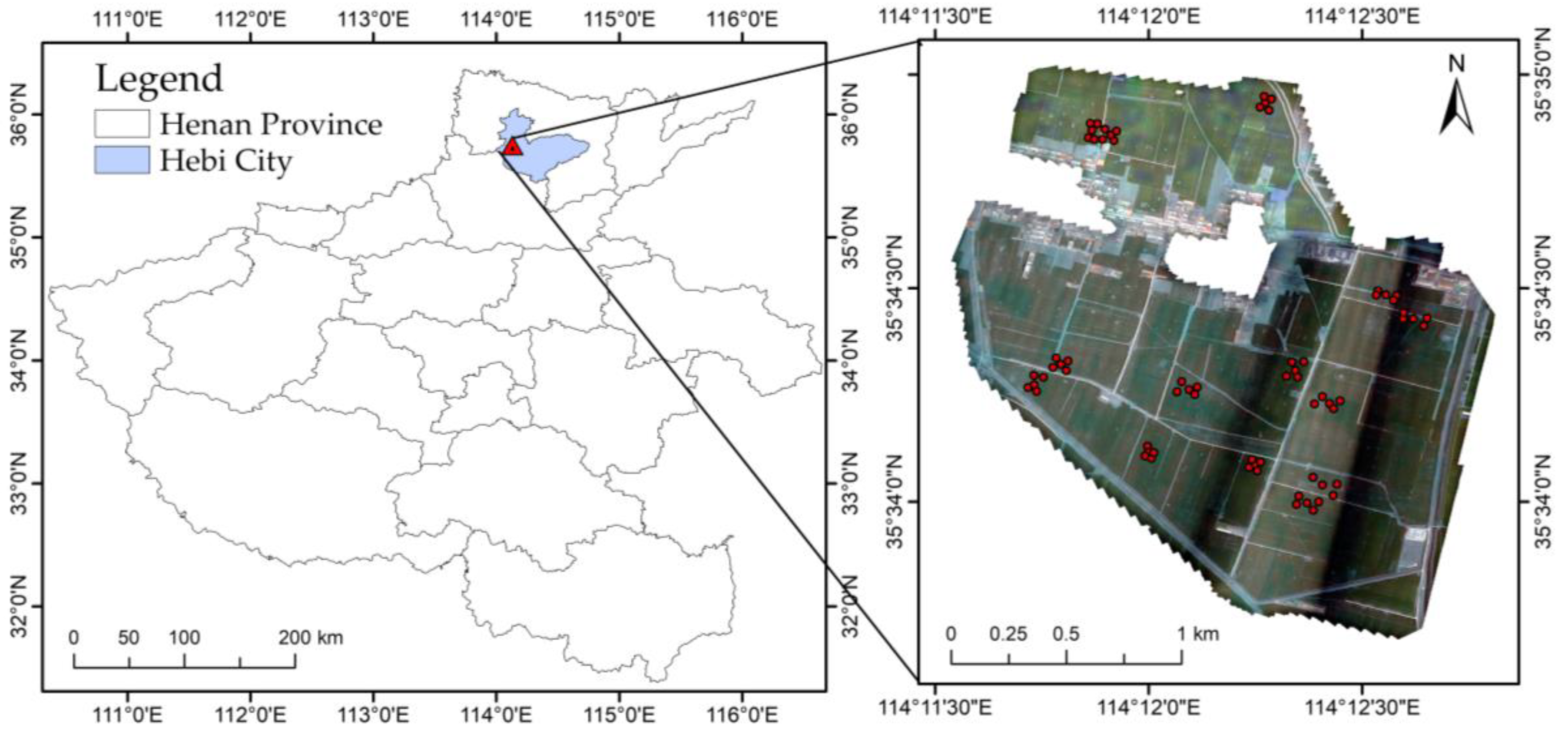
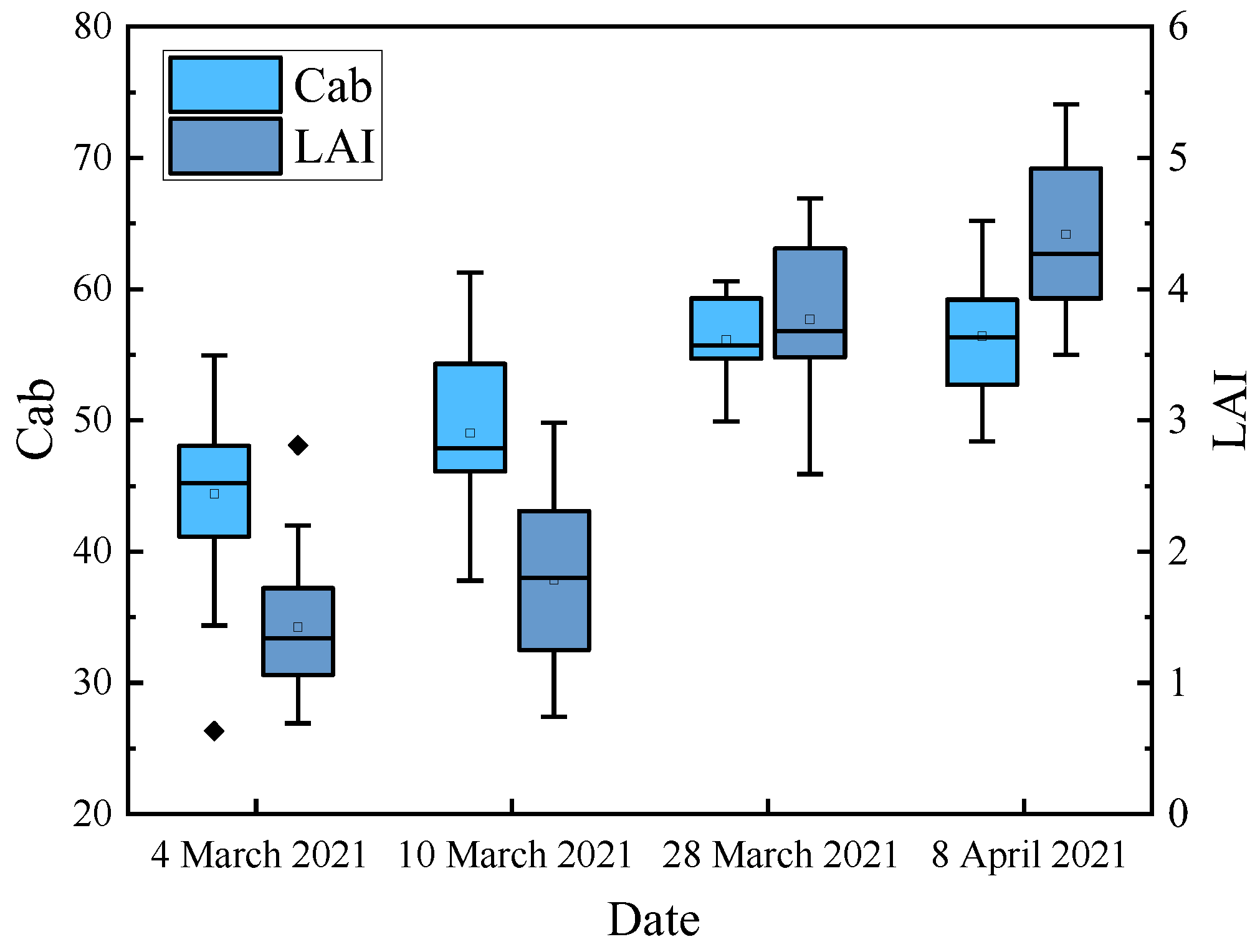
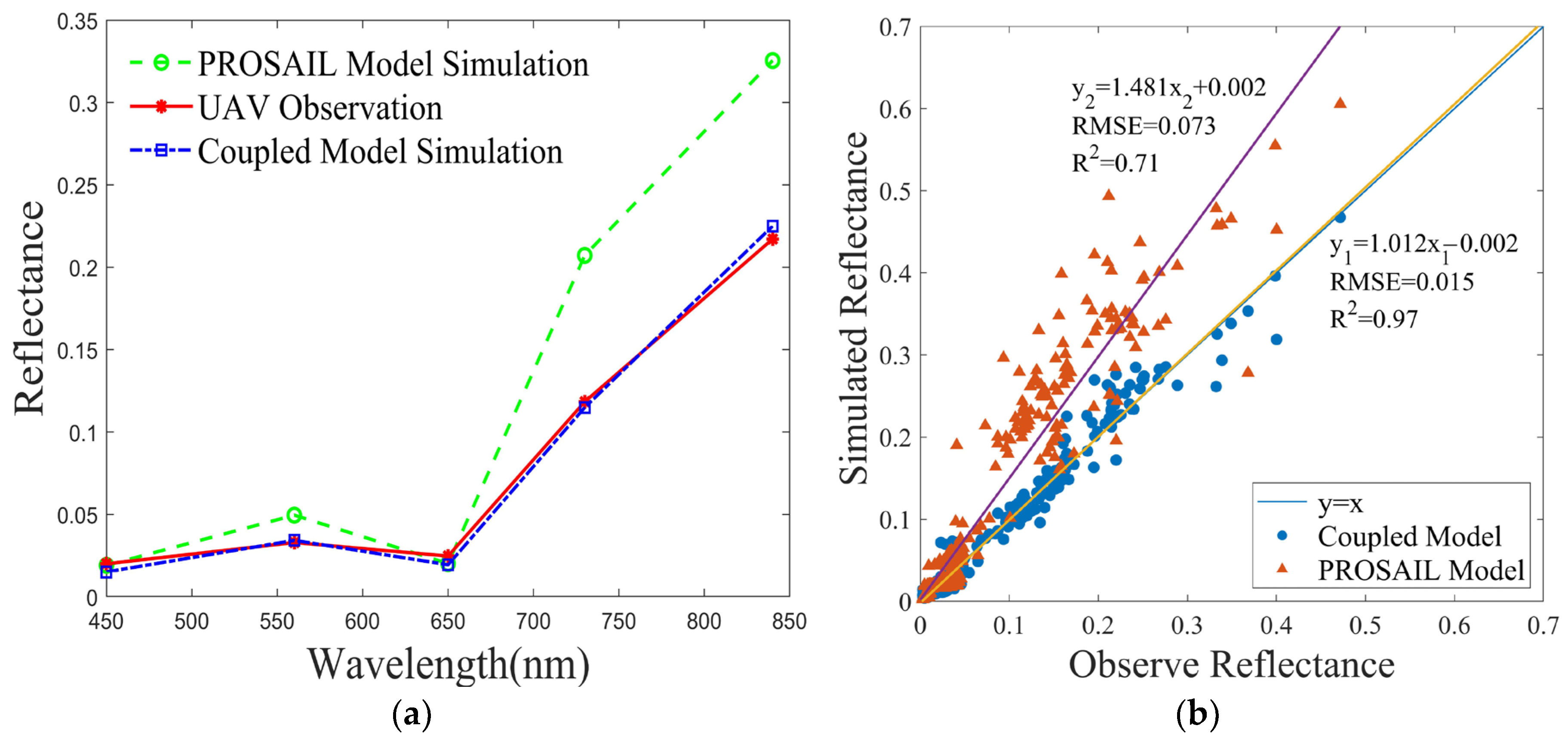
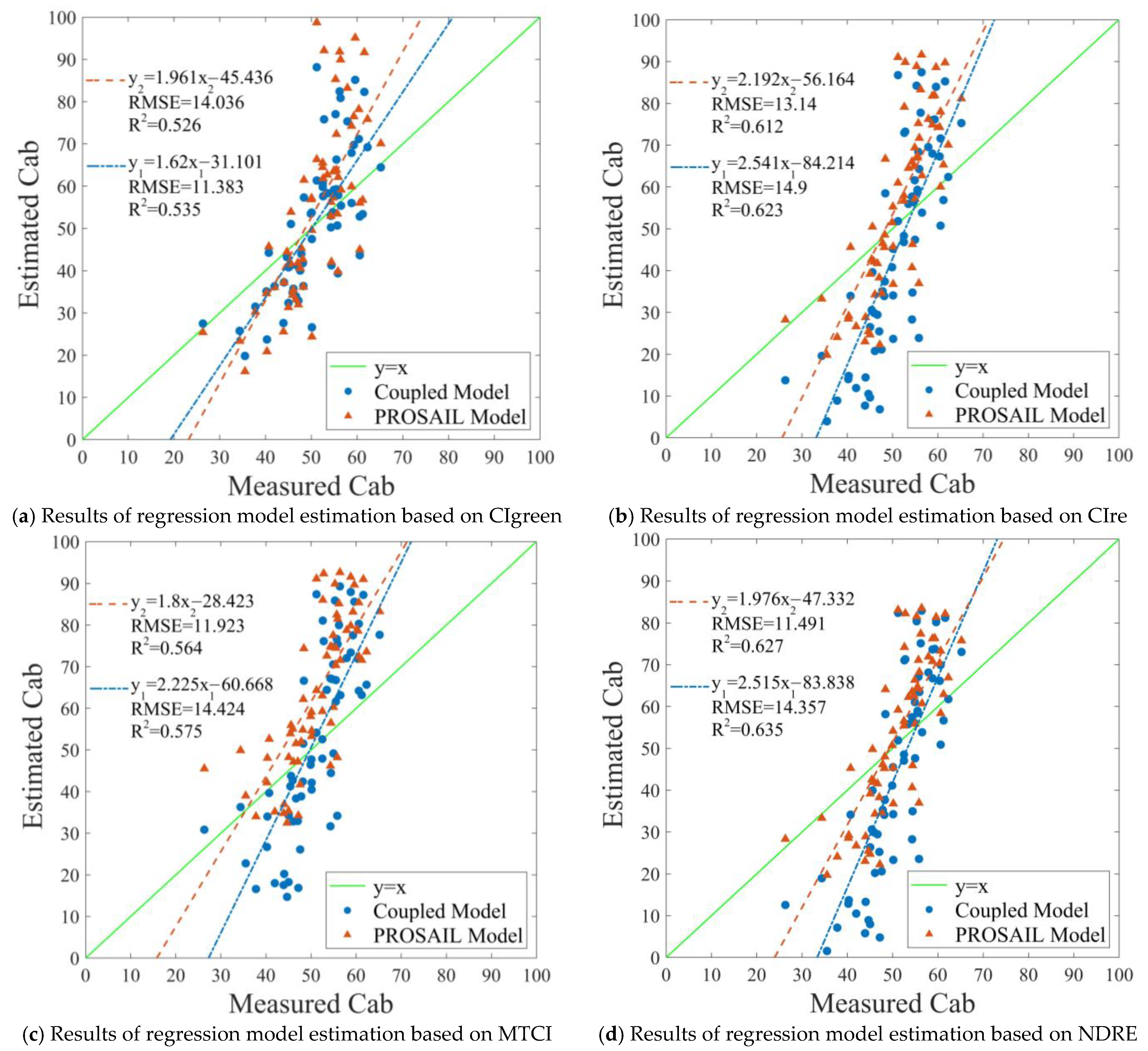

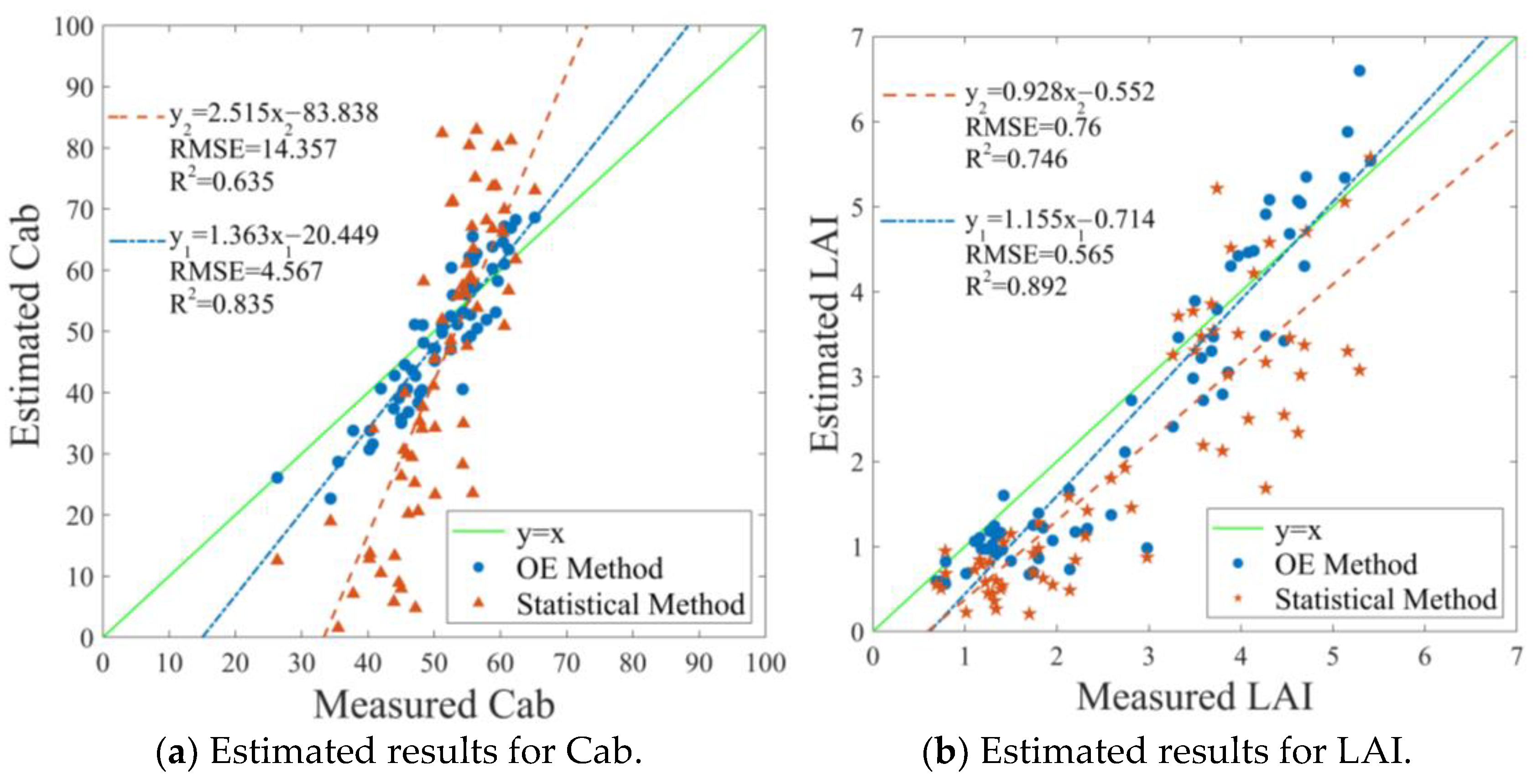
| Vegetation Index | Formula | References |
|---|---|---|
| NDVI (Normalized Difference Vegetation Index) | (R840 − R650)/(R840 + R650) | [36] |
| GNDVI (Green Normalized Difference Vegetation Index) | (R840 − R560)/(R840 + R560) | [37] |
| BNDVI (Blue Normalized Difference Vegetation Index) | (R840 − R450)/(R840 + R450) | [38] |
| RVI (Ratio vegetation index) | R840/R650 | [39] |
| CIgreen (Green Chlorophyll index) | R840/R560 − 1 | [40] |
| CIre (Rededge Chlorophyll Index) | R840/R730 − 1 | [40] |
| MTCI (MERIS Terrestrial Chlorophyll Index) | (R840 − R730)/(R730 − R650) | [41] |
| NDRE (Normalized Difference Red Edge Vegetation Index) | (R840 − R730)/(R840 + R730) | [42] |
| Parameter Variable | Vegetation Index | Model | R2 |
|---|---|---|---|
| Cab | CIgreen | y = 39.199 × ln(x) − 16.335 | 0.9716 |
| CIre | y = 65.285 × ln(x) + 59.777 | 0.9846 | |
| MTCI | y = 70.307 × ln(x) + 51.629 | 0.9942 | |
| NDRE | y = 90.016 × ln(x) + 158.27 | 0.9761 | |
| LAI | NDVI | y = 0.0021 × e(8.2122x) | 0.7082 |
| GNDVI | y = 15.97 × x6.8669 | 0.8405 | |
| BNDVI | y = 0.00008 × e(11.684x) | 0.7331 | |
| RVI | y = 0.6038 × e(0.0589x) | 0.9656 |
| Retrieval Methods | Retrieval Accuracy | |
|---|---|---|
| R2 | RMSE | |
| statistical regression | Cab: 0.635 | Cab: 14.357 |
| LAI: 0.746 | LAI: 0.76 | |
| LSSVM | Cab: 0.689 | Cab: 4.513 |
| LAI: 0.783 | LAI: 0.614 | |
| RF | Cab: 0.766 | Cab: 0.62 |
| LAI: 0.827 | LAI: 0.565 | |
| optimal estimation | Cab: 0.835 | Cab: 4.567 |
| LAI: 0.892 | LAI: 0.564 | |
Disclaimer/Publisher’s Note: The statements, opinions and data contained in all publications are solely those of the individual author(s) and contributor(s) and not of MDPI and/or the editor(s). MDPI and/or the editor(s) disclaim responsibility for any injury to people or property resulting from any ideas, methods, instructions or products referred to in the content. |
© 2024 by the authors. Licensee MDPI, Basel, Switzerland. This article is an open access article distributed under the terms and conditions of the Creative Commons Attribution (CC BY) license (https://creativecommons.org/licenses/by/4.0/).
Share and Cite
Ji, J.; Wang, X.; Ma, H.; Zheng, F.; Shi, Y.; Cui, H.; Zhao, S. Synchronous Retrieval of Wheat Cab and LAI from UAV Remote Sensing: Application of the Optimized Estimation Inversion Framework. Agronomy 2024, 14, 359. https://doi.org/10.3390/agronomy14020359
Ji J, Wang X, Ma H, Zheng F, Shi Y, Cui H, Zhao S. Synchronous Retrieval of Wheat Cab and LAI from UAV Remote Sensing: Application of the Optimized Estimation Inversion Framework. Agronomy. 2024; 14(2):359. https://doi.org/10.3390/agronomy14020359
Chicago/Turabian StyleJi, Jiangtao, Xiaofei Wang, Hao Ma, Fengxun Zheng, Yi Shi, Hongwei Cui, and Shaoshuai Zhao. 2024. "Synchronous Retrieval of Wheat Cab and LAI from UAV Remote Sensing: Application of the Optimized Estimation Inversion Framework" Agronomy 14, no. 2: 359. https://doi.org/10.3390/agronomy14020359
APA StyleJi, J., Wang, X., Ma, H., Zheng, F., Shi, Y., Cui, H., & Zhao, S. (2024). Synchronous Retrieval of Wheat Cab and LAI from UAV Remote Sensing: Application of the Optimized Estimation Inversion Framework. Agronomy, 14(2), 359. https://doi.org/10.3390/agronomy14020359









